On September 15, 1898, Stanislas Froidevaux and Joseph Gaibrois founded the watch company S. Froidevaux & Cie. in Porrentruy, in the Swiss canton of Jura.

Just a few months later, in January 1899, the company registered its two first trademarks, two interlocking gear segments and VORWÄRTS (Forward):
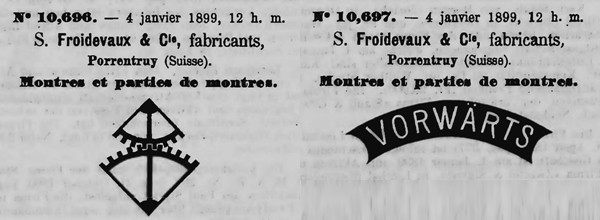
Incidentally, Joseph Gaibrois had founded his own company in 1896, with “butcher’s store” listed as its business purpose. Whatever may then have driven him to watchmaking. However, he died already in 1900.
Stanislas Froidevaux probably managed the company alone in the following years. In 1902, the Société des fabricants d’horlogerie du district de Porrentruy (Society of watchmakers of the Porrentruy district) was founded. Froidevaux became a member of the board of directors of this society, so he likely had some importance in the local watchmaking world of Porrentruy.
S. Froidevaux registered a number of other trademarks in 1902 and 1909, respectively:
- Atys (1902)
- Idole (1902)
- Jasmin (1902)
- Jota (1902)
- Sterna (1909)
- Dieda (1909)
- Eingriff (?)
By the way, Jota was also used as a brand by the German manufacturer Junghans, but the two companies had nothing to do with each other.

It was not until 1913 that there seems to have been a significant change in the company. On 20 February, Stanilas Froidevaux and Victor Bloch founded the Manufacture d’horlogerie Panthère St. Froidevaux & Bloch in Porrentruy.

The new company also registered a number of trademarks:
- Marine (1913)
- Panthère (1913)
- Planète (1913)
- Réclame (1913)
- Treue (1913)
- Siegreich (1917)

On 22.03.1923 the company was already dissolved again and all assets and liabilities were taken over by the newly founded Victor Bloch, Manufacture d’horlogerie Panthère on 09.04.1923. Froidevaux was therefore no longer a partner in the company at this point. However, the new company founded by Bloch was also dissolved in 1930.
Unfortunately, I could not find any further information about Stanislas Froidevaux and his company, for example about its size or its economic situation. Finding watches from Froidevaux is also not so easy. Although the company held numerous trademarks, almost all of the dials of the company’s pocket watches do not seem to have a trademark. They can therefore only be identified by the movements built into them, occasionally also by one of the marks in the cover of the watch.
Let’s take a look at the movements now! Fortunately, Froidevaux had a whole series of so-called models of movements reserved in the Swiss Official Gazette of Commerce (SOGC). The model numbers could be assigned as desired by the respective manufacturer. The model number is not an official calibre designation, but merely served to register the type of construction.
In most cases, the number followed a certain logic, such as consecutive numbering. We will see in a moment that Froidevaux was not so logical…
It all started on 22.01.1901 with model no. 1.

Less than two months later, on 15.03.1901, Froidevaux registered another model no. 1 as well as models no. 2, 3 and 4. So much for logic…

I even have an original specimen of this model no. 1:

This movement is hallmarked with the JOTA trademark and a reference to its registration in the SOGC: DÉPOSÉ No. 7851.
The Lépine (open face) movement shown has a diameter of 18 1/2´´´ (French lines), a cylinder escapement, 10 jewels and is crown winding with a pin pusher.
The next registration was on 25.02.1902 with another model no. 4, which visually has nothing at all to do with the previously registered model no. 4.

I was also able to get hold of a sample of this model, which is built into the pocket watch shown at the top:

This movement also contains a reference to the manufacturer, namely the VORWÄRTS trademark on the barrel bridge. This mark is also found on the inside of the cover of the pocket watch.
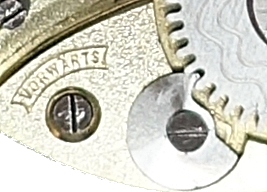
The Lépine (open face) movement shown has a diameter of 18´´´, a cylinder escapement, 10 jewels and is crown winding with a pin pusher.
This was followed by model no. 5 on 31.08.1903:

And model no. 6 on 20.11.1902:


It corresponds to model no. 1 of 15.03.1901 shown above, but has a modern Swiss lever escapement with 15 jewels and a bimetallic screw balance instead of the cylinder escapement! The diameter is 18 3/4´´´. This movement also bears a reference to its registration in the SOGC on the plate: DÉPOSÉ No. 9134. The movement shown is installed in this pocket watch:

The next registrations were in 1905 with further model numbers 1, 2 and again 2, the latter including only a center wheel bridge.
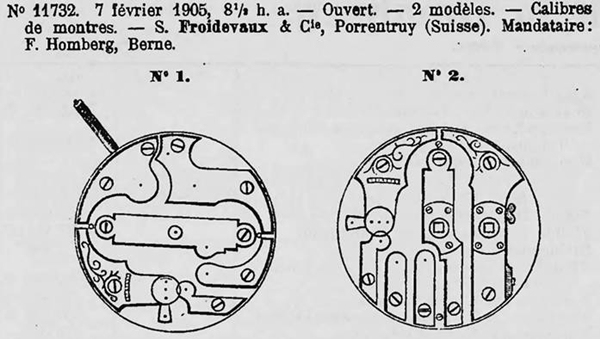

It again takes two years until 1907 for the next registration, this time a model no. 10.

We make a leap in time to the year 1913, i.e. after the merger of Froidevaux and Bloch. Interestingly, the numbering of the models with the numbers 11 and 12 follows the model no. 10 registered before that. However, the numbers 10 and 11 look identical to me!

Only a few months later, on 04.04.1914, the logical numbering ended again. There were again models with the numbers 1 and 2. So there are now already four models with numbers 1 and 2!

On 30.05.1914 Froidevaux & Bloch registered another model no. 4, so that there were now already three variants of it.
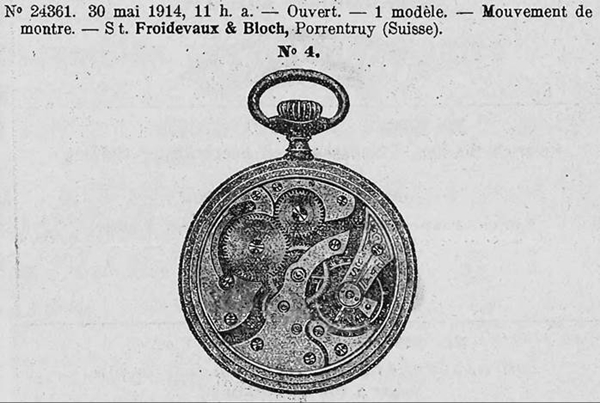
The last registration was on 28.03.1916 with – surprise – a fifth model no. 1.

I also found a specimen of this movement:

This movement has a diameter of 18´´´, a cylinder escapement, 10 jewels and is crown winding with a pusher pin. This movement is also available with the hallmark Siegreich of Froidevaux & Bloch:
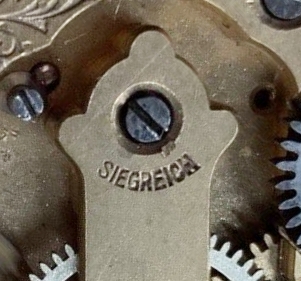
The following picture shows a variant of the Froidevaux model no. 1 from 1916, which is not listed in the Swiss Official Gazette of Commerce. They differ from each other only in a slightly different bridge shape and a slightly different dial side. The technical data are identical.

Only a few movement manufacturers have used model numbers of their registrations in the Swiss Official Gazette of Commerce more than once. Froidevaux is the only one I know of who caused such chaos in the numbering.
If any of my readers have further information on Stanislas Froidevaux, his companies or his movements, I would be delighted to hear from you!
